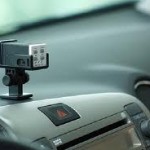Black Box technology in automobiles helps to record data related to accidents. Such data not only helps to determine the cause of the accidents in individual cases, but also may help in improving overall traffic safety, when aggregated. Today this technology is available in some of the cars including BMW, Benz, Audi, Volvo, Toyota and Ford.
 Components of Black box
Components of Black box
Unlike the complex setup of black box technology in airliners, the smart black box of automobiles contains a built-in camera, GPS unit and G-force shock sensor to record the accidents.
Black box records video footage
The black box constantly records the video footage of your drive. When the shock sensor detects an accident, the device saves the footage from 10 to 15 seconds before the accident and few seconds after the accident. This footage is saved in a SD card and can be accessible later. The GPS system in the system records the time and location of the accident and also gives the speed and travel direction.
Generally skid marks and steel deformation are used in reconstructing the event of an accident, but it is not reliable always. Black box technology for automobiles can help in finding the exact reasons for the collision.
Black box can provide insurance at a discounted rate
The data in event data recorders is helpful for the driver while claiming insurance, by showing the data saved at the time of accidents. It is also helpful to avoid penalty from cops if there is no fault with the driver.
In order to promote usage of black boxes, insurance companies are offering insurance at a discounted rate for the drivers using this technology in their cars. Many insurance companies are also ready to distribute this type of safety product to drivers. If the footage shows that the fault is with the driver, they can simply turn down his claim for the accident. Thus, it is a win-win for both good drivers as well as the insurance companies.
